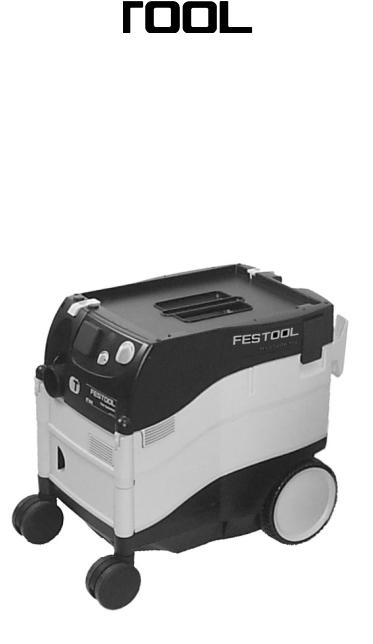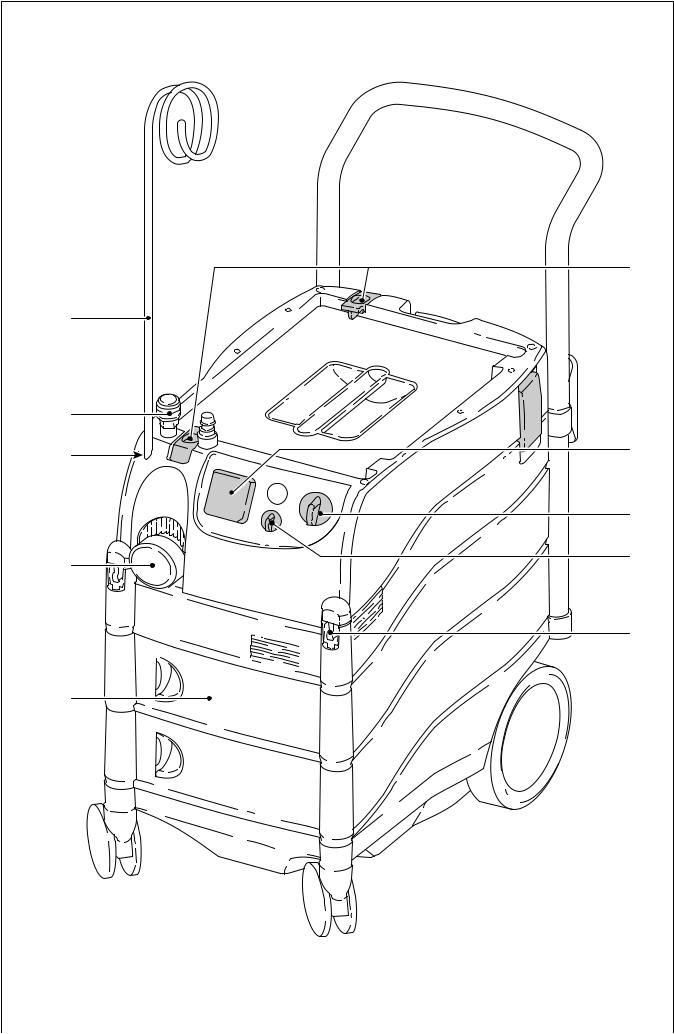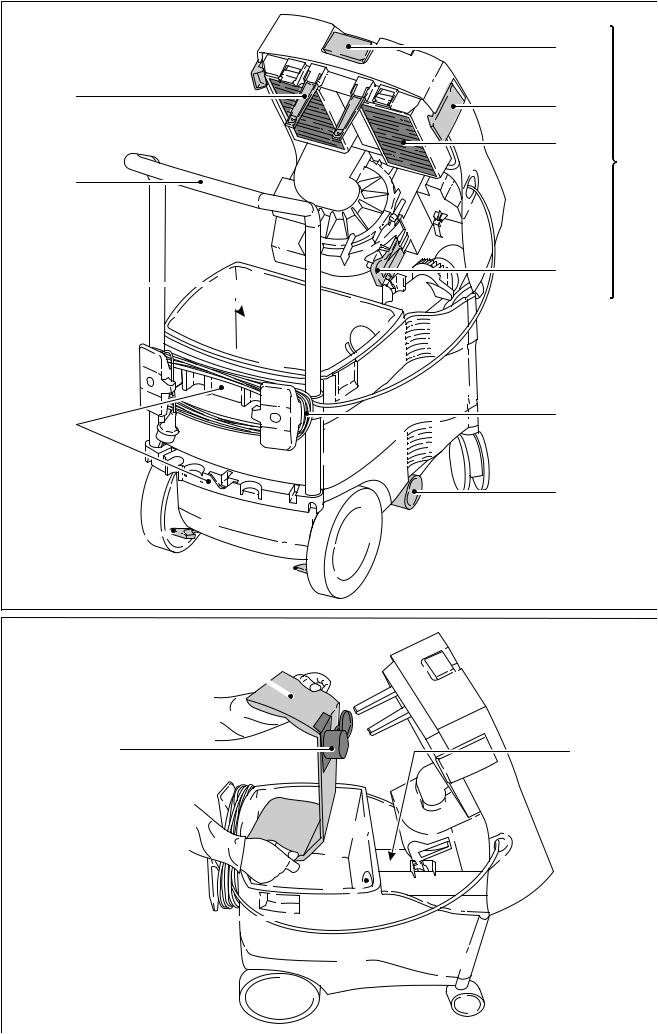Festool CT 22 E, CT 33 E User Manual

CT 22 E HEPA
CT 33 E HEPA
Instruction manual
Page 4 - 9
IMPORTANT: Read and understand all instructions before using.
Guide d’utilisation
Page 10 - 16
IMPORTANT: Lire et comprendre toutes les instructions avant de démarrer les travaux.
469 621_003
Manual de instrucciones
Página 17 - 23
IMPORTANTE: Lea y comprende todas las instrucciones antes de usar.
1

1.1
1.10
1.9
1.8 |
1.2 |
|
|
|
1.3 |
1.7 |
1.4 |
|
1.5
1.6
1
2

|
2.1 |
2.12 |
2.2 |
|
|
|
2.3 |
2.11 |
2.4 |
|
2.5
2.10
2.6
2.9
2.7
2.8
2
3.4
3.3 |
3.1 |
3.4
3
3

Contents |
|
Safety Rules ............................................ |
4 |
Technical data ......................................... |
6 |
Symbols .................................................. |
6 |
Intended use ........................................... |
6 |
Connections ............................................ |
6 |
Electrical connection ................................. |
7 |
Connecting the suction hose ...................... |
7 |
Connecting an electric tool ........................ |
7 |
Connecting pneumatic tools ....................... |
7 |
Equipment ............................................... |
7 |
Operation ................................................ |
7 |
On/off switch ........................................... |
7 |
Suction force regulator ............................. |
7 |
Opening/closing the vacuum cleaner .......... |
7 |
Emptying the dirt container ....................... |
7 |
Application .............................................. |
8 |
Vacuuming dry materials ........................... |
8 |
Vacuuming liquids .................................... |
8 |
Filter ....................................................... |
8 |
Changing the filter ................................... |
8 |
Cleaning the filter element ........................ |
8 |
After finishing work ................................ |
8 |
Maintenance and care ............................. |
8 |
Accessories, filter .................................... |
9 |
Warranty ................................................. |
9 |
Safety Rules



 Read and understand all instructions. Failure to follow all instructions listed below, may result in electric shock, fire and/or serious personal injury.
Read and understand all instructions. Failure to follow all instructions listed below, may result in electric shock, fire and/or serious personal injury.
SAVE THESE INSTRUCTIONS
General Safety Rules
Work Area
Keep your work area clean and well lit. Cluttered and dark areas invite accidents.
Do not operate vacuum cleaners in explosive atmospheres, such as in the presence of flammable liquids, gases, or dust. Appliances create sparks, which may ignite the dust or fumes.
Keep bystanders, children, and visitors away while operating the vacuum cleaner. Do not allow to be used as a toy. Close attention is necessary when used by or near children.
Electrical Safety
This vacuum cleaner intended only for use indoor and for dry or wet pick-up.
The power tool outlet is grounded and the vacuum cleaner must be plugged into an outlet properly installed and grounded in accordance with all codes and ordinances. Never remove the grounding prong or modify the plug in any way. Do not use any adapter plugs. Check with a qualified electrician if you are in doubt as to whether the outlet is properly grounded. If the vacuum cleaners should electrically malfunction or break down, grounding provides a low resistance path to carry electricity away from the user.
Do not insert objects like paper clips or screwdrivers into power tool outlet. The outlet is live when the vacuum cleaner is plugged into power source and switch is set to power tool activation mode or filter cleaning mode. Electric shock may occur.
Avoid body contact with grounded surfaces such as pipes, radiators, ranges and refrigerators. There is an increased risk of electric shock if your body is grounded. If operating the vacuum cleaner in damp locations is unavoidable; a Ground Fault Circuit Interrupter must be used to supply the power to your vacuum cleaner. Electrician’s rubber gloves and footwear will further enhance your personal safety.
Don’t expose vacuum cleaner to rain or wet conditions. This vacuum cleaner can be used for picking up non-flammable liquids but it is not intended to be immersed or submerged in a fluid. Electric shock may occur.
Do not handle plug or appliance with wet hands. Electric shock may occur.
Do not abuse the cord. Never use the cord to carry the vacuum cleaner, pull the vacuum cleaner or yank the plug from an outlet. Keep cord away from heat, oil, sharp edges or moving parts. Replace damaged cords immediately. Don’t drive over it or close a door on it. Damaged cords increase the risk of electric shock.
When operating a vacuum cleaner outside, use an outdoor extension cord marked “W- A” or “W”. These cords are rated for outdoor use and reduce the risk of electric shock. Refer to Recommended sizes of Extension Cords in the Accessory section of this manual.
Personal Safety and Vac-
uum Cleaner Use
Stay alert, watch what you are doing and use common sense when operating a vacuum cleaner. Do not use vacuum cleaner while tired
4

or under the influence of drugs, alcohol, or medication. A moment of inattention while operating vacuum cleaner may result in serious personal injury.
Avoid accidental starting. Be sure vacuum cleaner and tool switches are OFF before plugging in or putting vacuum cleaner switch into power tool activation mode or filter cleaning mode. Do not keep power tool plugged into the vacuum cleaner’s power tool outlet during normal vacuuming. Plugging in vacuum cleaners or tools that have the switch ON invites accidents.
Do not overreach. Keep proper footing and balance both for you and the vacuum cleaner at all times. Use extra care when cleaning on stairs. Proper footing and balance enables better control of the vacuum cleaner in unexpected situations.
Do not vacuum burning, smoking or smoldering things like cigarettes, matches or hot ashes. Fire inside the vacuum cleaner tank may occur.
Do not use to vacuum flammable liquids, alcohol, gases, or explosive dusts, like gasoline or other fuels, lighter fluid, varnish, polyurethane coatings, cleaners, oil-based paints, natural gas, hydrogen, coal dust, magnesium dust, grain dust, or gun powder.
Electric motors create sparks which may ignite the dust or fumes.
Dress properly. Do not wear loose clothing or jewelry. Contain long hair. Keep your hair, clothing, and gloves away from moving parts. Loose clothes, jewelry, or long hair can be caught in moving parts, hose, and suction nozzles. Keep handles dry, clean and free from oil and grease.
Do not hold the hose against any body parts during operation.
Use safety equipment. Always wear eye and hearing protection. Dust mask, non-skid safety shoes, hard hat, or hearing protection must be used for appropriate conditions.
Not suitable to vacuum hazardous or toxic substances or dusts e.g. asbestos. The filters will not be able to capture all particles and may exhaust them back into the environment.
Vacuum Cleaner Safety Rules
Vacuum cleaner Care
Do not use vacuum cleaner if switch does not turn it ON or OFF. Any vacuum cleaner that cannot be controlled with the switch is dangerous and must be repaired.
Disconnect the plug from the power source before making any adjustments, changing accessories, or storing the vacuum cleaner. Such preventive safety measures reduce the risk of starting the vacuum cleaner accidentally.
Never connect a tool with a rating greater than the maximum amperes listed on the receptacle. This vacuum cleaner has a power tool outlet for use in conjunction with other appliances such as sanders, jigsaws and planers; tools with greater ratings may cause a fire.
Do not vacuum dust when liquid/fluid is contained in the vacuum cleaner tank. Do not vacuum liquids/fluids when dust is in the tank. In either case empty the tank and/or remove dust bag before use so that dust does not cake and harden inside the tank.
Dry filters completely after wet vacuuming or use a second dry filter set for dust vacuuming. Damp or wet filters will cake with dust or develop mold or mildew.
Store idle vacuum cleaner out of reach of children and other untrained persons. Vacuum cleaners are dangerous in the hands of untrained users.
Maintain vacuum cleaner with care. Properly maintain vacuum cleaner to keep hose unobstructed. Do not put any object into openings. Do not use with any opening blocked; keep free of dust, lint, hair and anything that may reduce air flow. Any alteration or modification is a misuse and may result in a dangerous condition.
Check for misalignment or binding of moving parts, breakage of parts, and any other condition that may affect the vacuum cleaners operation. If damaged, have the vacuum cleaner serviced before using. Poorly maintained vacuum cleaners cause many accidents. Develop a periodic maintenance schedule for your vacuum cleaner.
Use only accessories that are recommended by the manufacturer for your model. Accessories that may be suitable for one vacuum cleaner may become hazardous when used on another vacuum cleaner.
Service
Only qualified repair personnel must perform vacuum cleaner service. Service or maintenance performed by unqualified personnel could result in a risk of injury. For example: internal wires may be misplaced or pinched, safety guard return springs may be improperly mounted.
When servicing a vacuum cleaner, use only identical replacement parts. Follow instructions in the Maintenance section of this
5

manual. Use of unauthorized parts or failure to follow the Maintenance Instructions may create a risk of electric shock or injury. Certain cleaning agents such as gasoline, carbon tetrachloride, ammonia, etc. may damage plastic parts.



 Various dust created by power sanding, sawing, grinding, drilling and other construction activities contains chemicals known (to the State of California) to cause cancer, birth defects or other reproductive harm. Some examples of these chemicals are:
Various dust created by power sanding, sawing, grinding, drilling and other construction activities contains chemicals known (to the State of California) to cause cancer, birth defects or other reproductive harm. Some examples of these chemicals are:
• lead from lead-based paints,
•crystalline silica from bricks and cement and other masonry products, and
•arsenic and chromium from chemically-treated lumber.
The risk from these exposures varies, depending on how often you do this type of work.
To reduce your exposure to these chemicals: work in a well ventilated area, and work with approved safety equipment, such as dust masks that are specially designed to filter out microscopic particles. Wash hands after handling.
Technical data
Power consumption .......................................................................................... |
350 - 1200 W |
Connected load to appliance plug socket max. ............................................................. |
1200 W |
Total connected load max.......................................................................................... |
2400 W |
Volume flow (air) max., turbine............................................................. |
228 m3/h (8.2 cu.ft./h) |
Vacuum max., turbine............................................................................................. |
23000 Pa |
Filter surface .................................................................................... |
14000 cm2 (2170 sq.in.) |
Suction hose, diameter x length........................................ |
27 mm x 3.5 m (1.06 in. x 11.48 ft.) |
Dimensions L x W x H: |
|
CT 22 E HEPA..................................................... |
625 x 380 x 440 mm (24.6 x 15 x 17.3 in.) |
CT 33 E HEPA..................................................... |
625 x 380 x 550 mm (24.6 x 15 x 21.6 in.) |
Container capacity: |
|
CT 22 E HEPA............................................................................................... |
22 l (5.7 gal.) |
CT 33 E HEPA............................................................................................... |
33 l (8.6 gal.) |
Weight: |
|
CT 22 E HEPA............................................................................................ |
12 kg (26.4 lbs) |
CT 33 E HEPA............................................................................................ |
14.5 kg (32 lbs) |
Power cable length ........................................................................................ |
7.5 m (24.6 ft.) |
Protection type ............................................................................................................ |
IP X4 |
The specified illustrations can be found at the beginning of the operating instructions.
Symbols
Vvolts
A amperes
Hz hertz
Wwatt
~alternating current
n0 no load speed
Class II Construction
The vacuum cleaner is designed in accordance with IEC 60335-1 and IEC 60335-2-69 for a higher loading in industrial use.
The filtering performance of the overall unit, which is fitted with a HEPA filter element (493334), corresponds to HEPA quality H 13 (medium degree of filtration 99.95 %).
All CT extractors fitted with the HEPA filter element (493334) have HEPA certification both for the filter material and the whole dust extractor.



 The user is liable for damage and injury resulting from incorrect usage!
The user is liable for damage and injury resulting from incorrect usage!
Intended use
The vacuum cleaner is designed for use as specified for the aspiration and evacuation of non-nox- ious dusts, dirt, sand, shavings etc..
The vacuum cleaner is designed as specified for vacuuming water.
Connections
Before start-up:
The accessories are delivered in the container (2.10), and must be removed prior to initial operation.
6

Electrical connection
The operating voltage and frequency shown on the specification plate must be the same as the mains power voltage (wall socket).



 Make sure that the vacuum cleaner is switched off when you plug the power cable in.
Make sure that the vacuum cleaner is switched off when you plug the power cable in.
The antistatic system (AS)
Friction in the suction hose causes electrostatic charges which can result in unpleasant electric shocks for the operator. In order to conduct these static charges to earth, the extraction units are provided with an antistatic system as a standard feature. However, antistatic hoses and accessories have to be used in this case.
The antistatic function will only work if the plug is plugged into a totally earthed socket.
Temperature control
A temperature fuse switches the dust extractor off before this reaches a critical temperature to protect against overheating - switch dust extractor off and leave for around 5 minutes to cool down.
If the dust extractor still cannot be switched back on, please consult a Festool-service centre.
Connecting the suction hose
Connect the suction hose at the extraction opening (1.7).
Connecting an electric tool
Observe the maximum connected load on the appliance plug socket (see “Technical Data“)!



 Make sure that the electric tool is switched off when plugging it in and unplugging it.
Make sure that the electric tool is switched off when plugging it in and unplugging it.
Connect the electric tool to the appliance plug socket (1.2).
Connecting pneumatic tools



 Make sure that the pneumatic tool is switched off when plugging it in and unplugging it.
Make sure that the pneumatic tool is switched off when plugging it in and unplugging it.
When the compressed-air module (1.9) (452829) is fitted, the automatic cut-in of the appliance also operates in conjunction with compressed-air tools.
We also recommend fitting of the VE supply unit (452797). The supply unit filters and oils the compressed air and allows the air pressure to be regulated.
An IAS connecting piece (454757) is available for connecting Festool compressed-air tools with the IAS system.
To ensure trouble-free functioning of the automatic cut-in, the operating pressure of the tool must be 6 bar.
Equipment
•Tools or accessories can be stowed in the storage compartments (1.6, not with CT 22 E HEPA).
•A systainer can be fixed on the shelf with the two clamps (1.1).
•An air blast is obtained by inserting a suction hose in the blast opening (2.7).
•Stand / Brake: the wheels can be blocked by the brakes (2.8), thus preventing the vacuum cleaner from rolling away unexpectedly.
Operation
On/off switch
In position O (1.3) the vacuum cleaner is switched off and the appliance plug socket (1.2) is dead.
Two modes of operation are possible:
a) Switch position „MAN“
The appliance plug socket is dead. The cleaner motor starts immediately.
b) Switch position „Auto“



 Before turning the switch to the „Auto“ position, ensure that the tool connected to the appliance plug socket is switched off.
Before turning the switch to the „Auto“ position, ensure that the tool connected to the appliance plug socket is switched off.
The appliance plug socket is live.
The cleaner motor starts only when the tool connected to the appliance plug socket is switched on.
Suction force regulator
The suction force regulator (1.4) can be used to vary the suction capacity. This permits a precise adaptation to different substances to be picked up.
Opening/closing the
vacuum cleaner
–Open retaining clamps (2.2) ,
–Raise upper part (2.4) until support catch (2.5) engages.
Follow the reverse order to close the appliance. You must raise the upper part slightly before depressing or disengaging the support.
Emptying the dirt container
 Always remove the upper part of the vacuum cleaner before emptying the dirt container (2.10)!
Always remove the upper part of the vacuum cleaner before emptying the dirt container (2.10)!
–Open the vacuum cleaner,
–Raise the upper part slightly, depress the support (2.5),
–Raise the upper part to the stop (vertical position),
7

–Remove the upper part by moving it forwards horizontally,
–Empty the dirt container,
–Replace the upper part. 


 Make sure that both upper-part pins are fully inserted in the recesses (1.5)!
Make sure that both upper-part pins are fully inserted in the recesses (1.5)!
–Close the vacuum cleaner.
Application
Vacuuming dry materials
Before using the vacuum cleaner to evacuate dry substances, a filter bag must always be inserted in the container. Then the evacuated material can be disposed of easily.
The filter element becomes damp after evacuating liquids. A damp filter element suffers more wear and tear if it is used for dry materials. Accordingly, the filter element should be dried or replaced with a dry one before dry operation.
Vacuuming liquids



 Do not evacuate combustible liquids!
Do not evacuate combustible liquids!



 If foam or liquid escapes, stop work immediately and empty the dirt container.
If foam or liquid escapes, stop work immediately and empty the dirt container.



 The HEPA filter element shall only be used for extracting dry materials.
The HEPA filter element shall only be used for extracting dry materials.
The filter bag has to be removed before evacuating liquids. We recommend use of a special wet filter (452924).
When the maximum filling level is reached, a bag-full indicator (2.12) automatically interrupts extraction.
Filter
Changing the filter



 During the following procedure, take care not to raise dust more than is unavoidable. Moisten the filter element with a water spray before removing it.
During the following procedure, take care not to raise dust more than is unavoidable. Moisten the filter element with a water spray before removing it.
Check the fill level of the filter bag at regular intervals. A full filter bag shall be replaced immediately.
Check the filter element for damage every time the filter bag is changed. Replace damaged filter elements immediately.
Always insert a filter bag when using a HEPA filter element.
Changin the filter bag (3.4)
Order no.:
CTL 22 E: 452970
CTL 33 E: 452971
–Open the vacuum cleaner,
–Remove the used filter bag (see printed text on filter bag),
–Dispose of the used filter bag in accordance with statutory requirements,
–Thoroughly clean the dirt container (2.10) and the space (3.1) for suction turbine (wipe down with a damp cloth),
–Insert new filter bag (see printed text on filter
bag). 


 Press the filter bag sleeve (3.3) firmly onto the dust extraction fitting (3.2)!
Press the filter bag sleeve (3.3) firmly onto the dust extraction fitting (3.2)!
–Close the vacuum cleaner.
Changing the filter element (2.3)
Order no. (CT 22 E, CT 33 E): Standard filter element: 452923 HEPA filter element: 493334
Do not operate machine without a filter element. This may damage the motor.
–Open the vacuum cleaner,
–Remove the used filter element (see printed text on the filter element packaging),
–Dispose of the used filter element in a sealed, dust-tight bag in accordance with statutory requirements,
–Thoroughly clean dirt container (2.10) and space (3.1) for the suction turbine (wipe down with a damp cloth),
–Fit a new filter element (see printed text on the filter element packaging),
–Close vacuum cleaner.
Cleaning the filter element
To clean, move the handle (2.1) to and fro about 10 times. N.B.: You need to clean the filter element only if you use the vacuum cleaner without a filter bag.
After finishing work
•Switch off the cleaner and pull the Plug of the mains lead out of the Plug socket.
•Wind up the mains lead (2.6).
•Empty dirt tank.
•Clean the vacuum cleaner inside and outside by suction and wiping.
•Deposit the appliance in a dry room, safe from unauthorised use.
Maintenance and care



 Always remove the power supply plug from the socket before carrying out any work on the machine.
Always remove the power supply plug from the socket before carrying out any work on the machine.



 All maintenance and repair work which requires the motor casing to be opened may only be carried out by an authorised service centre.
All maintenance and repair work which requires the motor casing to be opened may only be carried out by an authorised service centre.
8
